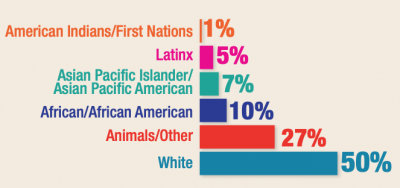Read All About It
Looking for inclusive children’s books? Check out the graduate school’s new blog.
by Carin Moonin
For the past few years, Alisun Thompson, assistant professor of teacher education, has asked graduate students in her Literacy Methods course to review four children’s books that highlight the experiences of historically marginalized communities.
Students chose books, turned in their reviews, and waited for their grades. In many ways, it was a traditional “book report” assignment.
But Thompson is always on the lookout for ways to enrich the classroom experience. Last autumn, she created an Instagram account, titled More Shelf Awareness, featuring her own reviews of social justice–themed children’s books. It didn’t take long for her students to begin following it and commenting. Given their enthusiasm, Thompson decided to start a class blog, also called More Shelf Awareness, to build teacher community and provide a platform for examining children’s literature that better reflects the diversity of today’s classrooms.
Although More Shelf Awareness is only in its first year, it already houses more than 60 reviews. Students tag posts with the issues they address—such as “bilingual,” “LGBTQ,” or “disability education”—making it easy to find topics.
Thompson believes the blog provides a platform for ongoing dialogue. “As students move out of Lewis & Clark’s program and into the classroom, the blog can let them continue to critically review books and talk about them,” she says.
Her hope is that the teacher-focused blog will flourish in the future, serving as a resource for educators, parents, and the community.
The Representation Gap
Demographic disparities between teachers and students are common. In 2016, the National Center for Education Statistics reported that fewer than 50 percent (48.7 percent) of students in U.S. public schools are white. That number is projected to decrease an additional 5 percent by 2024.
Yet about 80 percent of teachers are white, Thompson says. This may be self-perpetuating, as many students of color don’t grow up with teachers who resemble them at the front of their classrooms. Also, teachers are likely to return to the books they loved as children, creating a representation gap.
“Whiteness prevails in the classroom,” she says. “If we don’t do something to disrupt it, we aren’t meeting the needs of the majority of students, who won’t see their lived experiences in what they read at school.” (See related article on next page.)
Thompson believes we should view books through a model called “Mirrors, Windows, and Sliding Glass Doors,” developed by author of color Rudine Sims Bishop. Books should mirror who we are, act as windows to other lives, and serve as sliding glass doors to step into new experiences.
A Positive Disruption
As part of its mission, the Lewis & Clark Graduate School of Education and Counseling is committed to providing a learning environment built around the values and practices of social justice. This commitment begins before students are even enrolled: applicants to the Teacher Education Program must articulate in both speech and writing how social justice informs their desire to teach.
The More Shelf Awareness blog helps teachers follow through on this commitment, Thompson says. “It’s a concrete way teachers can engage in social justice education and do something new in the classroom by having books and experiences different from the norm,” she adds.
Caroline Ludlow MAT ’20 believes it’s important to talk about identity and our place in the world, especially in an elementary school setting. “It’s our job as educators to be aware of these issues and our responsibility around them,” she explains.
Putting Words Into Action
In addition to educational literacy, More Shelf Awareness enhances digital literacy. Blogs and social media use abound throughout the educational world, Thompson says, and she encourages students to employ digital platforms in their own lesson plans.
“In the blog, we include ideas about how teachers can use the books in real-world classrooms,” says Courtney Farmer MAT ’20. “That’s been helpful in pushing us to think of possible academic activities to align with what kids are reading.”
Quin Nelson MAT ’20 enjoys the writing aspect of the blog. “It lets me slow down and think deeply about what makes a book interesting, what questions I have about it, and what can be useful to teachers.”
Reading Into the Future
Even though there is still much work to be done, many wonderful children’s books highlighting diversity issues have been published in the last 10 to 15 years, Thompson says. She maintains an impressive children’s literature library of her own with about 350 books.
“There are some amazing works written by authors of color and members of the LGBTQ+ community as well as books about diverse family structures, and more,” she says. “It’s an exciting time to be a teacher in the children’s literature world. I’d like to see our classrooms reflect that.”
Carin Moonin is a Portland-based freelance writer.
The Need for Increased Diversity in Children’s Books
More Shelf Awareness recently published a blog post titled “The Representation Gap and Why it Matters,” which includes data from the University of Wisconsin at Madison’s School of Education. It shows that diversity in children’s books remains extremely low. For more information visit the More Shelf Awareness blog.
Diversity in Children’s Books
Percentage of books depicting characters from diverse backgrounds:

Based on 2018 statistics compiled by the Cooperative Children’s Book Center, School of Education, University of Wisconsin at Madison.
More L&C Magazine Stories
Lewis & Clark Magazine is located in McAfee on the Undergraduate Campus.
MSC: 19
email magazine@lclark.edu
voice 503-768-7970
fax 503-768-7969
The L&C Magazine staff welcomes letters and emails from readers about topics covered in the magazine. Correspondence must include your name and location and may be edited.
Lewis & Clark Magazine
Lewis & Clark
615 S. Palatine Hill Road MSC 19
Portland OR 97219


